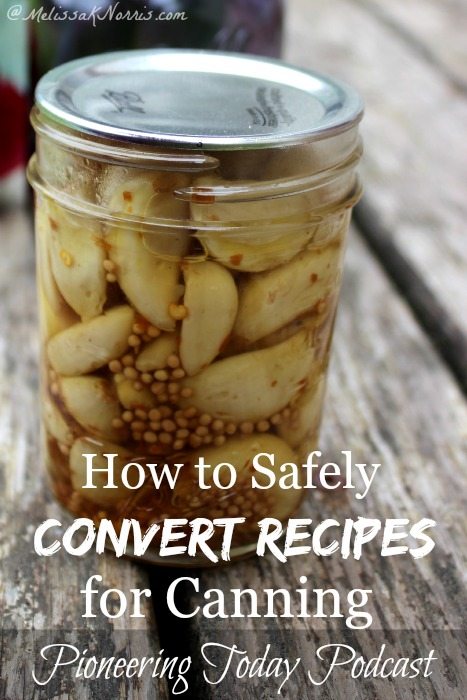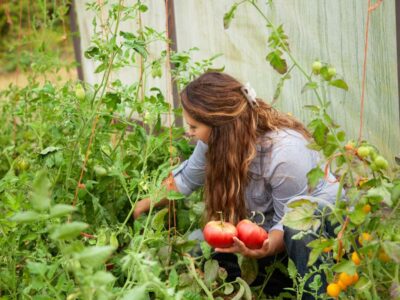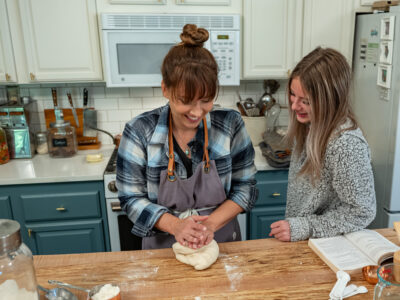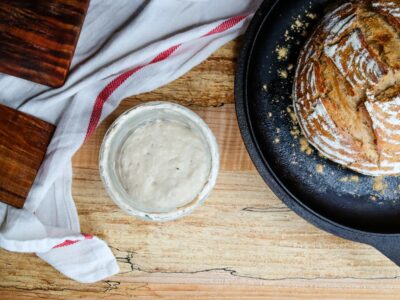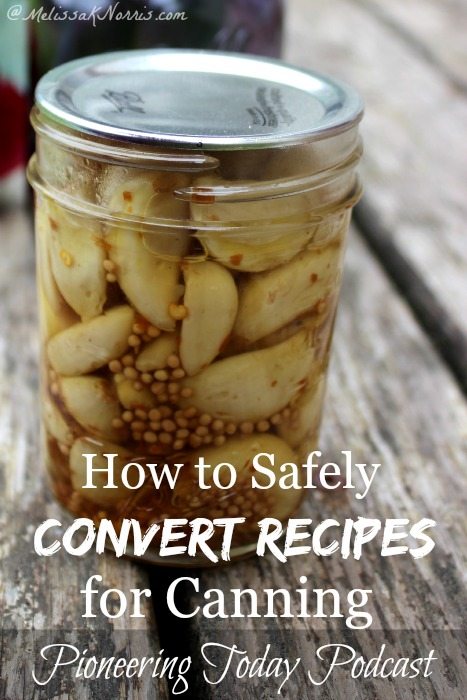
Want to learn how you can safely convert recipes for canning? Learn these important safety tips for home canning, plus how to convert your combination recipes into safe canning recipes!
Canning safety is very, very important and I do see a lot of misinformation passed around on the internet on what is safe to can at home and what are the proper guidelines. The USDA has specific canning safety guidelines you may want to learn more about.
Today we're going to be talking about canning safety and safe ways to convert recipes to make them safe to can.
We're talking with Sharon from Simply Canning.com I reference her website a lot when I personally have a canning question. I post new episodes every Friday morning. You can subscribe via RSS and receive every episode for free. ![]() Or subscribe via Itunes
Or subscribe via Itunes
Resources for Safe Canning and Converting Canning Recipes
Simply Canning Soups– soups are considered a combination canning recipe and when canned at home, have some important modifications to make the safe. This book walks you through how to convert your own favorite soup recipes to canning recipes, plus more recipes for your canning fun.
Simply Canning the Book (paperback)- Ever wished you had a knowledgeable best friend to walk you through canning the right way? This book is loaded with canning advice and recipes. For the digital version go here.
Re-Usable Tattler lids– Learn how to use the only canning lid that's re-usable. Canning is already frugal, but a re-usable lid just made it more so.
Canning Safety Tips
Melissa: Welcome, Sharon!
Sharon: Thank you for having me.
Melissa: Do you want to go into your background and how you got started or in canning?
Sharon: I didn't grow up canning or in that lifestyle. Shortly after I got married, 20 years ago, my mom called and asked if I wanted her pressure canner. I almost turned her down and then thought well those are pretty expensive maybe I better take it. So I got it and tried it out and I got hooked. I started off with the easy stuff and I didn't have a huge garden at that point. But over the years things have grown and as I've done a lot of research on and I'm really particular about safety. I”m kind of like you and can almost everything, we freeze a few things, but I can meat, vegetables, jams, jellies, and pickles.
Melissa: I actually love that you didn't grow up with a canning background, I did and I'm very grateful for that, but I feel a lot of times people feel intimated if they didn't grow up with it, but you show that anyone can start or learn how to can.
Sharon: I get contacted a lot by young women who mother's canned, but they didn't actually participate with their mom and they have vague remembrances of, “well I think mom did this or that”, but if you don't know make sure you research and know you are doing what mom did or maybe what mom did isn't safe anymore. It's really important to do your research.
Melissa: Speaking of research and safety issues, what are some common things that people tend to email you or say my mom or grandma used to do this, but it's really not a safe practice to do anymore today? People will talk to their grandma and not know it's no longer considered safe. Or they might be reading an older canning book that don't have up to date safe practices.
Sharon: The two things are people want to use a boiling water bath for vegetables or they don't know the proper tomato canning guidelines. Some people used to water bath can vegetables. They would boil it for hours and hours thinking the length of time would make it safe, because of the length of time, but the water bath canner can't get up to the temperature you need it no matter how long you boil it, the pressure canner brings up your temperature to stop botulism. Botulism is the bad bacteria, but it's really easy to avoid. People get scared when you mention botulism, but if you use the proper time and pressure you'll avoid botulism.
Some people think if you open the jar and smell it, and it doesn't smell you're good. Some spoilage you can see or smell. I've had tomatoes go bad and they're all bubbly. But that's not the case with botulism, I wish it was. You can't see it or smell it. That's the biggest one. When I first started my website I had my page on how to can green beans. I had so many people asking if you could water bath green beans and I don't let that question anymore so I think people have found that.
There are even people out there who are listening to day saying I do that and it's fine. There's no canning police. You decide what to do in your kitchen. I'm just telling you what I believe to be true and what is recommended with all the testing. So we can agree to disagree but I probably won't eat your green beans if I come to your house.
The second thing is tomatoes. If you want to can tomatoes in a water bath you need to acidify them. Tomatoes have changed in their acidic levels with all the hybrids and they're kind of border line. It's recommended to add lemon juice to your jars before processing.
You add the lemon juice right to the jar so you know each jar has the right amount.
Melissa: When a recipe calls for lemon juice, make sure you're using bottle lemon juice, not fresh lemon with tomatoes, use concentrated not fresh to make sure it's the right acidic level.
Sharon: Same thing goes with vinegar and pickling. You need to use store bought 5% vinegar, not homemade vinegar to make sure it's the correct strength.
Melissa: I haven't seen vinegar at the store less than 5%, but make sure your vinegar is 5%.
Sharon: I think maybe specialty vinegars might be less, I always buy the gallon size vinegar.
Melissa: I use my pressure canner for applesauce because it takes less time than the water bath. But I still use lemon juice with my tomatoes in the pressure canner, and you won't taste the lemon juice in the end product.
Sharon: You commented you pressure can your applesauce in the pressure canner but I”m at high altitude so I have issues with liquid loss. Do you have problems with that in the pressure canner?
Melissa: I'm just at 300 feet so I don't have high altitude issues. I don't have much liquid loss. Once the pressure canner is cooled normally (not running under cold water) I take the lid off and let the jars sit in the pressure canner for an hour sometimes before moving to the counter on a towel, so I don't have much liquid loss. When I can fruit in the pressure canner, it's only at 5 pounds of pressure and a short time.
Sharon: It takes me longer to get up to pressure because I”m at 6,000 feet.
Melissa:I'm glad you brought that up, because altitude definitely affects how long you process and the pounds of pressure. Do you use the re-usable Tattler canning lids? How to Use Re-Usable Tattler Lids
Sharon: I do, not exclusively, but I have used them quite a bit.
Melissa: I noticed when I do applesauce with it, it creates like a vacuum suction, even thought I always practice recommended head space guidelines. If you don't know, head space is the space between the top of the food and the rim of the jar. Usually 1 inch for meat and 1/4 inch for jam or jelly. With the Tattle lids, it looks I did no head space, but when you open it, there's just a bit of applesauce against the glass on the edge, so it looks like there's no head space. Have you experienced that?
Sharon: No, I haven't noticed that. I know Tattler has a new style lid out called a self-venting lid. I haven't used them yet.
Melissa: I love with pressure canning having meals basically ready to go. I can come home on a busy night, grab a couple of jars, and can have supper on the table in 15 minutes. I generally boil my food for 10 minutes before serving, though if you didn't practice safe canning guidelines, boiling won't kill botulism. But it will kill other food bacteria. I don't know if that's older canning guidelines, but I've always boiled my food, which is why I say it takes about 15 minutes to get the food on the table.
I love being able to get supper on the table super quick, usually all home grown by us. I know a lot of people want to be able to can soup. People assume if you can buy it in a can on the store shelf, then you can do it at home. But store canners can reach higher temperatures.
How to Safely Convert a Combination Recipe for Canning
Sharon: I get that question a lot too. If you can buy a product with noodles in it can you do it at home? But it's a difference of equipment with home canners and commercial. You don't want to add any thickeners or pasta to your soup when canning it. You can add the pasta later when you're getting ready to serve it. It's a really easy thing to avoid.
Melissa: How about dairy? I see people saying conflicting things on adding dairy. My understanding, correct me if I'm wrong, is you shouldn't add dairy because doesn't hold up to canning well and isn't recommended, is that true?
Sharon: Correct, but when you say it that way, it sounds like a texture or quality issue. But it is a safety issue. The hard part is, I cannot find, so if anyone has found something out there that says why, all the canning websites and extension websites say you can't can cream or dairy. I chose not to, I can't picture milk holding up very well. The only reason I see is there are fats in the dairy and that could hold botulism spores. It's one of those things if I could find a specific resource that says why, that would be wonderful.
Melissa: I'm like you, I personally don't. I err on the side of caution with canning. I've grown up on canning and canned the fifteen years we've been married, but I practice the safety guidelines.
Sharon: A lot of people ask questions on canning potato soup, because it has dairy. Just make your base without the dairy, can that, and then add your dairy when you reheat it and serve. Can potatoes with chicken broth and follow proper guidelines, don't puree it. When you go to serve it, then puree it and add your dairy.
Melissa: So basically, if you're using a recipe and want to can soup, no noodles.
Sharon: Yes, no noodles, no rice, no pasta.
Melissa: No pureeing, which is really important, because store bought soups are pureed. It's not safe to can pumpkin butter, because it's not acidic and it's so thick the heat can't get through enough to ensure safety. I'm assuming that's the same reason for not pureeing and then canning the soup?
Sharon: Right. When you can soup, fill your jar half way with solid ingredients, and then fill your jar the rest of the way with the liquid. That keeps it thin enough all the ingredients will get heated through and then when you want to serve it, just puree it then.
Melissa: I want to talk about your canning books. Like I said I go to your site quite often when I'm canning if I have a question. You have two canning books out, correct?
Sharon: Yes.
Melissa: Your first canning book is just basic canning recipes.
Sharon: It's basically the entire website in book form.
Melissa: The second book, which is the one I was really excited about, because I don't have as much experience in canning combination recipes, which is what a home canned soup recipe is considered a combination recipe. You have a soup canning e-book, can you go over what's in that one?
Sharon: Simple Soups is what's its called. I give simple instructions on how to adapt a soup recipe for canning. I've given you directions on how to make soups from home canned foods. I have a couple of recipes on how to make and can soup, and then how to take your jars of home canned foods and make dinner. So more cooking with home canned foods than just a full on soup canning book.
Melissa: A lot of us homesteaders or preparedness folks, we have a lot of food in our pantry, with dehydrated and home canned foods. Sometimes you can look at it and say I have all of this food, but I don't know what to cook for dinner or pull it together to make a meal.
For those of you who are hunters, you have an entire book on how to prepare and can elk and venison recipes, right?
Sharon: Yes, I have an entire book on elk and venison recipes. In the book I tell you how to can via raw pack, hot pack, and even ground, or in cubes. I give recipes for making stews, casseroles, chili, all made from canned venison. People always ask now that I have all this canned meat, what do I do with it. It's different than cooking with frozen or fresh meat.
Melissa: I'm excited about that because my son and I are taking a hunter safety course this summer. So I've cooked venison but I've never had enough to can and preserve. Fingers crossed that will change this fall. I'm really excited, if I haven't said that already, like really excited that you have a book on it
Sharon: We're big hunters and eat a lot of wild meat. My husband hunts and our four sons. We always have a lot of elk and venison around, including mule deers here in Colorado.
Melissa: I'm excited to adding hunting to my skill set. I'm sure there will be a few podcasts around it.
Every canner, from beginners to seasoned, will enjoy Sharon's Simply Canning website and books Click here to visit Simply Canning., because let's be honest, one can never have too many canning recipes.
Want to get both books together to save money? Because truthfully, who doesn't want to save money? That's one of the main reason's why I can my food. You can get two of the books bundled together to save money.
You can also check out her paperback version on Amazon of Simply Canning.
More Articles on Home Food Preservation
- What Causes Canning Lids to Buckle? (+ Proper Tightening)
- Tips for Home Food Preservation – Seasonal Preserving Each Month
- A Complete Guide to Home Food Preservation (What to do When You Can’t Find Canning Supplies)
- Home Food Preservation- Preserving Plan for a Year’s Worth of Food
- 9 Ways to Preserve Food at Home
- How to Store Home Canned Food Safely – Jar Stacking & Canning Rings
- 129+ Best Canning Recipes to Put Up This Year
- How Do You Know if a Canning Recipe is Safe
- How to Pick the Best Preserving Methods
- The Science of Home Food Preservation
